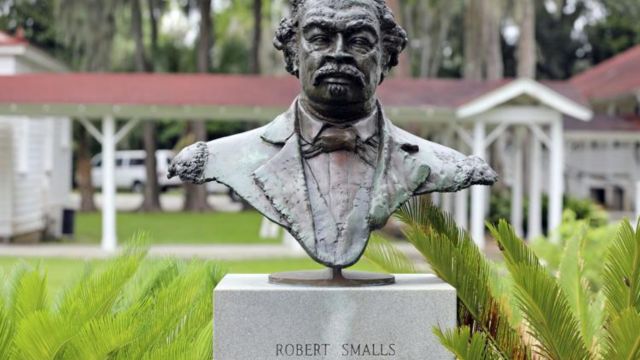BEAUFORT, S.C.—South Carolina is getting ready to honor a man who dressed as a Confederate soldier to steal a slave owner’s ship and sail his family and 12 others to freedom during the Civil War with the state’s first statue of an African American person. The statue will be placed on the lawn of the Statehouse.
But Robert Smalls is being praised for more than just his daring escape. During his ten years in the U.S. House, he helped change South Carolina’s constitution to give Black men equal rights after the Civil War. He then fought bravely, but in vain, when racists took back power and undid most of the progress he had worked for.
That’s why Rep. Jermaine Johnson can’t wait to take his kids to the Statehouse and finally see a Black person like them being recognized.
“The man has done so many great things that it’s a shame he hasn’t been recognized until now.” He also said, “It’s a shame that there isn’t a big Hollywood movie about his life.” Johnson is a Democrat from a seat not far from the Statehouse.
A figure of Smalls has been thought about for a long time. But there was always quiet resistance that kept bills from being heard. In 2024, that changed when Republican Rep. Brandon Cox of Goose Creek pushed the bill through the state House and Senate with no changes made.
“South Carolina is a great state.” We have a lot of past, both good and bad. “This is our good history,” Cox said.
How will the memorial for Robert Smalls look?
A special group was set up by the bill. They have until January 15 to come up with a design, a spot on the Statehouse lawn, and the money to pay for any memorial they decide on.
But supporters are faced with a tough question: what is the best way to remember Smalls?
Is it best to honor the tough ship captain who waited for the white crew to leave and then imitated hand signals and whistle toots to get through Confederate checkpoints in May 1862, hoping that the soldiers wouldn’t see the black man under the hat in the pale moonlight?
Perhaps a better way to honor Smalls would be to honor the politician who served in the South Carolina House and Senate and the U.S. House after the Civil War. Smalls bought his master’s house in Beaufort with some of the money he got from turning over the Confederate ship to Union forces. He then let the man’s widow live there when she lost her husband.
Or is it the elder Smalls who worked to open schools for everyone and to protect the gains black people made during the Civil War who should be remembered in public? Black people would no longer be able to vote under a new constitution that was passed in 1895. A lot of Black men were fired from their government jobs in 1913 when Woodrow Wilson was president. He was fired from his job as a federal customs inspector.
Or do you think it would be better to put them all together? That’s how Republican Rep. Chip Campsen, who is sometimes a ship pilot, plans to honor one of his favorite South Carolinians.
Campsen said, “Robert Smalls’ life was a fight for freedom as a slave, a pilot, and a politician.”
Yes, yes, yes to place
Then there’s the matter of where it is. There are twenty-two monuments around the Statehouse in South Carolina, but only one of them honors a single Black man or woman. The other twelve statues honor the struggles of African Americans from the time they were brought to America on slave ships until now.
At least six monuments honor people like Dr. J. Marion Sims. Some people call him the “father of modern gynecology,” but his study was based on operating on slave women and girls without anesthesia. Several monuments in the state started the Civil War that remember Confederates who fought to protect slavery. A marble copy of the Articles of Secession is also hanging in the lobby between the House and Senate chambers.
“Pitchfork” Ben Tillman, a governor and U.S. senator, is on the shady list. He brazenly said that he led groups of white people who killed Black men who were trying to vote in the 1876 election, which ended Reconstruction, brought back all-white rule, and brought down everything Smalls had worked for. That information is not on the plaque for Tillman’s statue.
Some fans have said that Smalls’ statue should be put next to Tillman’s and be taller and more noticeable. This would give Smalls a victory that has been coming for 130 years.
With a plan in mind, organizers think it will be easier to raise the money once the design and location are set.
Shane Massey, the Republican leader in the Senate, said, “We have to get the story right.” “This is going to have a story.” Telling that story in the right way is a way to honor him and South Carolina. It looks cool to me.
The important life of Robert Smalls
Robert Smalls was born in Beaufort in 1839 and died there in 1915. He was free, but not well known, and had a life that a woman carrying her son who was born into slavery could never have imagined. Now his supporters have a chance to make sure he never goes away.
“Robert Smalls writes a new future for this county that no one can see happening right now,” said Chris Barr, who is in charge of interpretation at the Reconstruction Era National Historic Park in Beaufort. He was standing next to a bust of Smalls near his grave in his hometown.
Barr said the most interesting thing about that life was driving a Confederate boat to freedom.
As Barr put it, “If you’re a slave working on one of these boats around Charleston Harbor like Robert Smalls, you have the tools, the talent, the boat, and you know how to drive it. And you can see freedom floating in the form of the US Navy just a few miles offshore.” “All you need is the chance.”
Source: South Carolina to build state’s first individual monument honoring an African American


 by
by 




